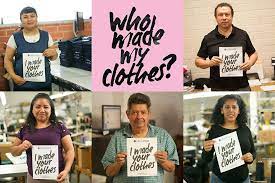
Fashion Revolution
Share
Fashion Revolution Week is the time when we come together as a global community to create a better fashion industry. It centers around the anniversary of the Rana Plaza factory collapse, which killed 1,138 people and injured more than 2,500 on 24 April 2013. (from https://FashionRevolution.com)

The Rana Plaza collapse was a structural failure that occurred on 24 April 2013 in the Savar Upazila of Dhaka District, Bangladesh, where the eight-story commercial building collapsed.
The building contained clothing factories, a bank, apartments, and several shops. The shops and the bank on the lower floors were immediately closed after cracks were discovered in the building. The building's owners ignored warnings to avoid using the building after cracks had appeared the day before. Garment workers were ordered to return the following day, and the building collapsed during the morning rush-hour.
It housed a number of separate garment factories employing around 5,000 people, several shops, and a bank. The factories manufactured apparel for brands including Benetton, Bonmarche’, Prada, Gucci, Versace, Moncler, the Children’s Place, El Corte Ingles, Joe Fresh, Mango Matalan, Primark, and Walmart.
The head of the Bangladesh Fire Service & Civil Defence, Ali Ahmed Khan, said that the upper four floors had been built without a permit. Rana Plaza's architect, Massood Reza, said the building was planned for shops and offices – but not factories. Other architects stressed the risks involved in placing factories inside a building designed only for shops and offices, noting the structure was potentially not strong enough to bear the weight and vibration of heavy machinery.
On 23 April 2013 (one day before the collapse), a TV channel recorded footage that showed cracks in the Rana Plaza building. Immediately afterward, the building was evacuated,[22] and the shops and the bank on the lower floors were closed. Later in the day, Sohel Rana the building owner, said to the media that the building was safe and workers should return tomorrow. Managers at Ether Tex threatened to withhold a month's pay from workers who refused to come to work. (From Wikipedia)

This event is what started Fashion Revolution and made more people pay attention to the plight of the worker in the garment industry.
You may have seen the above picture or one like it that triggers you to think about who made your clothes. Why is that important? If we pay attention to the labels in the clothes and other products we buy and make an effort to buy at least some of our clothing, jewelry and other products from Fair Trade sources or sources that have transparency in their supply chain, we will start to make a change for the workers in the factories who make our clothing and products.
This disaster brought the awareness to many who had not paid much attention to it before and things started to change. The t-shirts we use for our Baskets and Beads products have been verified to use fair trade practices or practices that ensure the workers rights are considered and that workers earn fair wages and are treated fairly and have safe working conditions.
What can you do to be part of the Fashion Revolution? Look into what products you use that you can perhaps change to Fair Trade products. Clothing, Chocolate, Coffee, Tea, Sea Food, Sugar and many more products. Read labels and learn where things are made. Do research. Pick one or two of your products to start with. A small ripple can make a difference that builds to a rolling wave. Do your part, buy Fair Trade.
Looking for Fair Trade jewelry, baskets and gifts? Check out our online store.
Nakupenda
Eldonna
